Aberrant Proliferation of Differentiating Alveolar Cells Induces Hyperplasia in Resting Mammary Glands of SV40-TAg Transgenic Mice
- PMID: 25019062
- PMCID: PMC4071642
- DOI: 10.3389/fonc.2014.00168
Aberrant Proliferation of Differentiating Alveolar Cells Induces Hyperplasia in Resting Mammary Glands of SV40-TAg Transgenic Mice
Abstract
WAP-T1 transgenic mice express SV40-TAg under control of the whey acidic protein (WAP) promoter, which directs activity of this strong viral oncogene to luminal cells of the mammary gland. Resting uniparous WAP-T1 glands develop hyperplasia composed of TAg positive cells prior to appearance of advanced tumor stages. We show that cells in hyperplasia display markers of alveolar differentiation, suggesting that TAg targets differentiating cells of the alveolar compartment. The glands show significant expression of Elf5 and milk genes (Lalba, Csn2, and Wap). TAg expressing cells largely co-stain with antibodies to Elf5, lack the epithelial marker Sca1, and are hormone receptor negative. High expression levels of Elf5 but not of milk genes are also seen in resting glands of normal BALB/c mice. This indicates that expression of Elf5 in resting WAP-T1 glands is not specifically induced by TAg. CK6a positive luminal cells lack TAg. These cells co-express the markers prominin-1, CK6a, and Sca1, and are positive for hormone receptors. These hormone sensitive cells localize to ducts and seem not to be targeted by TAg. Despite reaching an advanced stage in alveolar differentiation, the cells in hyperplasia do not exit the cell cycle. Thus, expression of TAg in conjunction with regular morphogenetic processes of alveologenesis seem to provide the basis for a hormone independent, unscheduled proliferation of differentiating cells in resting glands of WAP-T1 transgenic mice, leading to the formation of hyperplastic lesions.
Keywords: SV40-TAg; alveologenesis; hyperplasia; mammary gland; tumorigenesis.
Figures
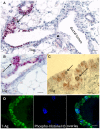
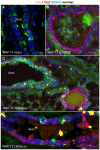

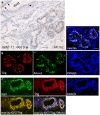
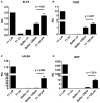
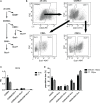




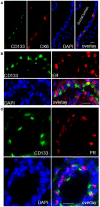
Similar articles
-
Impaired CK1 delta activity attenuates SV40-induced cellular transformation in vitro and mouse mammary carcinogenesis in vivo.PLoS One. 2012;7(1):e29709. doi: 10.1371/journal.pone.0029709. Epub 2012 Jan 3. PLoS One. 2012. PMID: 22235331 Free PMC article.
-
Expression of a viral oncoprotein during mammary gland development alters cell fate and function: induction of p53-independent apoptosis is followed by impaired milk protein production in surviving cells.Cell Growth Differ. 1996 Jan;7(1):3-11. Cell Growth Differ. 1996. PMID: 8788028
-
Lactation-induced WAP-SV40 Tag transgene expression in C57BL/6J mice leads to mammary carcinoma.Transgenic Res. 1998 Jul;7(4):253-63. doi: 10.1023/a:1008865911660. Transgenic Res. 1998. PMID: 9859214
-
Aberrant development of mammary glands, but precocious expression of beta-casein in transgenic females ubiquitously expressing whey acidic protein transgene.J Reprod Dev. 2005 Oct;51(5):579-92. doi: 10.1262/jrd.17024. Epub 2005 Sep 30. J Reprod Dev. 2005. PMID: 16195641
-
WAP-TAg transgenic mice and the study of dysregulated cell survival, proliferation, and mutation during breast carcinogenesis.Oncogene. 2000 Feb 21;19(8):1010-9. doi: 10.1038/sj.onc.1203271. Oncogene. 2000. PMID: 10713684 Review.
Cited by
-
Cellular stress responses in cancer and cancer therapy.Front Oncol. 2014 Oct 29;4:304. doi: 10.3389/fonc.2014.00304. eCollection 2014. Front Oncol. 2014. PMID: 25401089 Free PMC article. No abstract available.
-
T-cell epitope strength in WAP-T mouse mammary carcinomas is an important determinant in PD1/PD-L1 immune checkpoint blockade therapy.Oncotarget. 2016 Oct 4;7(40):64543-64559. doi: 10.18632/oncotarget.11620. Oncotarget. 2016. PMID: 27579535 Free PMC article.
References
-
- Abdel-Fatah TM, Powe DG, Hodi Z, Reis-Filho JS, Lee AH, Ellis IO. Morphologic and molecular evolutionary pathways of low nuclear grade invasive breast cancers and their putative precursor lesions: further evidence to support the concept of low nuclear grade breast neoplasia family. Am J Surg Pathol (2008) 32(4):513–2310.1097/PAS.0b013e318161d1a5 - DOI - PubMed
LinkOut - more resources
Full Text Sources
Other Literature Sources
Research Materials

